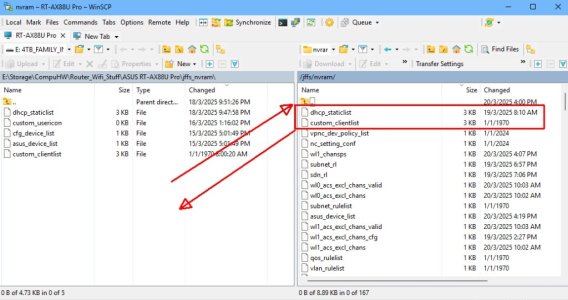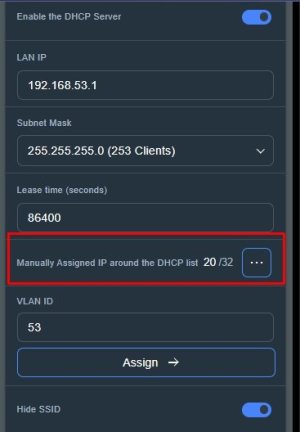As noted a few times in various posts I’ve been using WinSCP and just saving several files from the router containing dhcp reservation details, then copying them back into /jffs/nvram, for many years, without issue.
For one fixed DHCP list (under the LAN, DHCP tab) that 3004 FW had, it worked fine for me (although I will admit @Tech9 noted some concerns).
There are currently (now) 4 methods I know of for saving just the DHCP Lists (excluding Backupmon which does a wholescale backup). These are:
So, does anyone know:
(i) where these new lists are kept; and
(ii) can I download them or access them as before and upload replacements if I ever do a factory reset, without borking the entire system?
It's no good exporting the Client List from the Network Map (even though you can do this), because that is just a snapshot of what is online at any one time and you can't put it back anyway.
I am happy to input most setup details from screencaps, but the total 64# DHCP in the primary network PLUS now up to 32# (times five VLANs???) is a lot of IP Addresses and Custom Names to enter back by hand.
Ta.
[EDIT] To add the very useful and still reasonably simply dnsmasq.conf.add approach used by Jeffrey Young
For one fixed DHCP list (under the LAN, DHCP tab) that 3004 FW had, it worked fine for me (although I will admit @Tech9 noted some concerns).
There are currently (now) 4 methods I know of for saving just the DHCP Lists (excluding Backupmon which does a wholescale backup). These are:
- Via SSH (putty etc.) using the nvram commands summarised in this post; credit to @ColinTaylor
- Using WinSCP by just copying (drag and drop) the dhcp_staticlist and custom_clientlist files from /jffs/nvram across to a local drive (and back when you needed to); this was my preferred option, see attachment.
- Via the YazDHCP Addon, which I do not use, so I have no idea how it works; I am loathe to install it just for the backup feature and as RMerlin noted here, Guest Network Pro adds Static Lists for Guest Networks, so YazDHCP is less relevant in that regard.
- Via amendments to the dnsmasq.conf.add file that already exists in /jffs/config/ used by Jeffrey Young who references this source for format.
Line format is:
Code:dhcp-host=[<hwaddr>][,id:<client_id>|*][,set:<tag>][,tag:<tag>][,<ipaddr>][,<hostname>][,<lease_time>][,ignore]
Example from Jeffrey Young, with lease time:
Code:dhcp-host=00:90:A9:3B:5F:01,192.168.0.14,homecloud,3600
So, does anyone know:
(i) where these new lists are kept; and
(ii) can I download them or access them as before and upload replacements if I ever do a factory reset, without borking the entire system?
It's no good exporting the Client List from the Network Map (even though you can do this), because that is just a snapshot of what is online at any one time and you can't put it back anyway.
I am happy to input most setup details from screencaps, but the total 64# DHCP in the primary network PLUS now up to 32# (times five VLANs???) is a lot of IP Addresses and Custom Names to enter back by hand.
Ta.
[EDIT] To add the very useful and still reasonably simply dnsmasq.conf.add approach used by Jeffrey Young
Attachments
Last edited:




